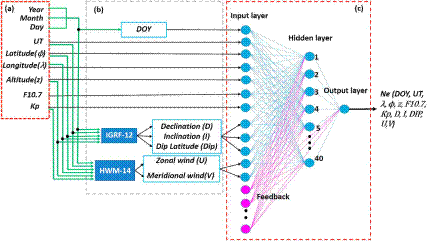New model to predict ionospheric electron density can help ommunication/navigation
New Delhi: Researchers from Indian Institute of Geomagnetism (IIG), Navi Mumbai, an autonomous institute of the Department of Science & Technology, Govt. of India, have developed a global model to predict the ionospheric electron density with larger data coverage—a crucial need for communication and navigation.
Dr. V. Sai Gowtam, with his research supervisor Dr. S. Tulasiram from IIG, has developed a new Artificial Neural Networks based global Ionospheric Model (ANNIM) using long-term ionospheric observations to predict the ionospheric electron density and the peak parameters.
ANNs replicate the processes in the human brain (or biological neurons) to solve problems such as pattern recognition, classification, clustering, generalization, linear and nonlinear data fitting, and time series prediction, and very few attempts have been made to model the global ionosphere variability using ANNs.
Tracking the variability of the Ionosphere is important for communication and navigation. The ionospheric variability is greatly influenced by both solar originated processes and the neutral atmosphere origin, therefore, difficult to model. Scientists have tried to model the ionosphere using theoretical and empirical techniques; however, the accurate prediction of electron density is still a challenging task.
In recent years, the Artificial Neural Networks (ANNs) are showing potential to handle more complex and non-linear problems. Keeping these aspects in mind, a novel machine learning approach was implemented by the IIG team in the ionospheric model development using global ionospheric observations.
The researchers developed a neural network-based global ionospheric model by using an extensive database consisting of nearly two decades of global Digisonde (an instrument that measures real-time on-site electron density of the ionosphere by sending the radiofrequency pulses), Global Navigation Satellite System (GNSS) radio occultation and topside sounders observations. These datasets were processed with various quality control measures to eliminate spurious data points (outliers) and prepared for the training. Day number, Universal Time, latitude, longitude, F10.7 index (responsible for Photo-ionization), Kp (represents the disturbed space weather conditions), magnetic declination, inclination, dip latitude, zonal and meridional neutral winds were taken as inputs in the study. The target (output) of ANNs is the electron density as a function of altitude for any given location and time. The data was trained with the ANNs using high-performance computer at IIG to develop the ANNIM.
The ANNIM predictions done by the IIG team matched with the incoherent scatter radar and the satellite in situ electron density observations. Further, the ANNIM successfully reproduced large scale anomalies of the ionosphere. The ANNIM also captured the general morphological features of the ionosphere during the disturbed space weather periods, such as geomagnetic storms which occurs when the magnetic cloud originated from Sun (known as Coronal Mass Ejection (CME)) interacts with the Earth’s magnetosphere
The model developed by IIG researchers may be utilized as a reference model in the ionospheric predictions and has potential applications in calculating the Global Navigation Satellite System (GNSS) positioning errors.

